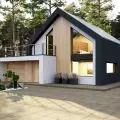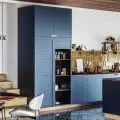Upper Silesia, a region with a rich industrial history, is facing numerous challenges resulting from economic and social transformation. Former industrial centers, once vibrant with life, often remain forgotten, and their degradation becomes a symbol of the difficulties faced by local communities. Innovative solutions are needed to restore life to these spaces and help integrate the Silesian community. In response to these challenges, Dominika Bednarek created the "Silesian Community House" in Bytom, which won SARP's Annual Zbyszek Zawistowski "Diploma of the Year" Award. Her concept of transforming the former Bobrek Steelworks into a place that fosters the development and integration of the local community is an example of an architectural approach that can influence the reconstruction of Upper Silesia and restore it to its former glory.
photos
© Dominika Bednarek
silesian paradigm
Upper Silesia, once Poland's industrial powerhouse, has become a place of significant transformation, with serious consequences for local communities. Technological advances and changes in the employment structure have led to a decline in the importance of traditional industries such as mining and metallurgy. The Bobrek steel mill, which operated until 1994, is a prime example of this process. Its closure meant not only the loss of jobs for thousands of residents, but also the disintegration of a community, for decades united by a common workplace, aspirations and daily life. These transformations, for which the region was unprepared, resulted in social exclusion, as well as progressive infrastructure degradation. Former workers' settlements such as Bobrek, once bustling centers, are now turning into degraded areas, and their residents and inhabitants are struggling economically and socially.
site development plan
© Dominika Bednarek
A shadow of the past or a chance for a new beginning?
Negligence on the part of the authorities, the lack of effective revitalization policies and long-term uncertainty about the future of these areas are leading to a loss of identity and a sense of belonging among the Silesian community. Post-industrial lands, once a source of pride for the local community, now often remain forgotten, with the ruins of the Bobrek steel mill as an example of this decline. Such places require urgent revitalization efforts to prevent further social exclusion and level the playing field for their male and female residents.
mockup
© Dominika Bednarek
Initiatives such as the "Silesian Community House" can be the first steps toward social and cultural reconstruction, bringing life back not only to the steel mill itself, but to the entire region. Rebuilding identity and community is crucial in the context of Upper Silesia's contemporary challenges. The project not only renews the physical space, but also proposes a model of cooperation and integration, taking into account the needs of the people of Silesia and its rich cultural heritage.
axonometry
© Dominika Bednarek
revitalization key to renewed identity
Dominika Bednarek's analysis indicates the wide range of issues to which the designed facility should respond. Faced with the complexity and scale of the issue, she singled out three key aspects: society, identity and the environment. She also took into account the assumptions of the Bytom 2020+ Municipal Revitalization Program, pointing out the need to increase the professional competence of residents and introduce recreational and cultural functions.
facades
© Dominika Bednarek
Situated in a historic district, the building refers to the context of the place, being an expression of respect for the surroundings and complementing the urban planning of the estate. The proportions of traditional familoks, consistency of materials and colors inspired by Silesian folklore were used, so that residents and residents perceive it as an integral part of the neighborhood. A key goal of the project is to create a comfortable place for dialogue and development, corresponding to the lifestyle of the community while maintaining a contemporary character. It is also important to refer to the former function of the Bobrek Steel Mill as the center of the neighborhood's life, which is achieved by exposing the foundations of the dismantled mill and replicating the characteristic retaining wall. This wall should intrigue and encourage visitors, not be a barrier. The reconstruction process relied on archival photos from the smelter's glory years, restoring the memory of this important place for the local community.
visualization of the main
© Dominika Bednarek
dialogue with history
The newly designed building refers to the nearby buildings by maintaining similar proportions and dispersion of masses, blending into the fabric of the neighborhood and land development. Openings in the structure of the building were planned along the existing traffic routes, fostering integration with the surroundings. Although the building has a contemporary character and original body, it does not dominate the existing buildings of the estate. Situated along the western and southern boundaries of the plot, it mimics the outline of the once-functioning steel mill.
functional scheme
© Dominika Bednarek
The building is divided into three separate zones: the main part, underground parking and a service pavilion, which are connected by a common communication system. The eastern part of the plot has been designated as a park, covering the area where the steel mill was once located. The roof of the parking lot serves a recreational function, offering space for children, a badminton court and a summer gym. The service area is enriched with a community garden, integrating the community and drawing on the tradition of the old gardens between the familoks. A key aspect of the project is to adapt the facility to the needs of people with disabilities. Service spaces and kitchen facilities have been designed with people with mobility limitations in mind, which can also create jobs for residents of this group.
entrance
© Dominika Bednarek
space that connects
The first floor of the building is divided into three key zones: a spacious hall with an exhibition function, a workshop area and an auditorium. The hall includes a reception desk with a checkroom and a representative staircase, as well as exhibition space for local artists. A skylight in the roof provides adequate lighting. A workshop area, located in the west wing, promotes the development of individual interests of residents.
The auditorium, located in the east wing, is accessible from a foyer connected to the hall, where access control takes place. It seats 120 guests and has an exit to the summer performance area. Film screenings and other cultural events are scheduled for the eastern wall.
courtyard
© Dominika Bednarek
The second floor includes an administrative area and a common room, accessible from level 0 via an external staircase. The west wing includes offices and a room for professional, psychological and legal counseling. The common room, connected to the administration by an open corridor, offers space for relaxation and use of computers. Completing the project is a service pavilion that includes a market area and a café with a tourist information desk. The market area offers local products, providing an alternative to a supermarket, while the café provides convenient access to beverages for summer event attendees, with seating and bookshelves.
material and eco-friendly solutions
The project uses mixed construction, combining wood and precast reinforced concrete. The service pavilion and parking lot use reinforced concrete columns and a green utility roof, while the two-story lobby also uses reinforced concrete for the first-floor community center structure. The two-story auditorium and workshop area with administration is made of CLT timber, reinforced with glulam timber frames. The façade is divided into upper and lower sections, where wood and recycled building blocks such as concrete and brick were used, a reference to the history of the steel mill. An important aspect of the project is the preservation of the existing graffiti wall, a trace of the estate's modern history.
garden
© Dominika Bednarek
The project used eco-friendly recycled materials such as demolition bricks and wood for the structure and facade. Thanks to low heat transfer coefficients, the building provides energy savings. The reinforced concrete prefabricated elements used will streamline the construction process. An efficient drainage system and rainwater tanks have also been installed, which will make it possible to partially meet the demand for water. Sustainable technologies such as a heat pump for heating and cooling and photovoltaic panels for solar energy have also been used.
interior
© Dominika Bednarek
Is this a new chapter for Bobrek?
The condition of industrial buildings and settlements in Upper Silesia is alarming, and intervention to improve their condition and protect cultural heritage is becoming urgently needed. "The Silesian Community House has the potential to become a key site in Bytom, supporting the development of Bobrek's residents and inhabitants and contributing to improving the quality of life in the region. The facility is a form of showing a possible way forward for places with a difficult history. It immortalizes the complicated fate of the settlement while trying to take care of its better future.
detail
© Dominika Bednarek





































































